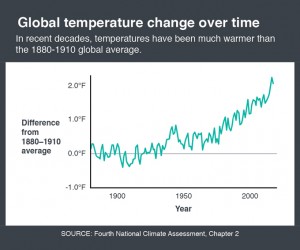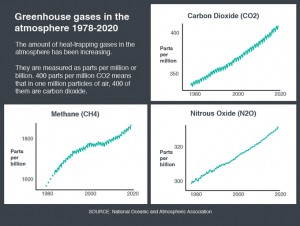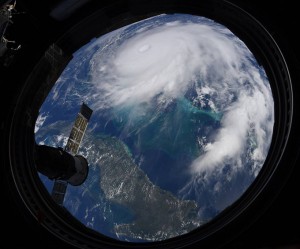From an Article by Samantha Harrington, Yale Climate Connections, March 27, 2020
You likely have heard about global warming in the news, at school or from a friend. And so you probably have questions such as, “What is causing this warming?” and “What role do humans play in that warming?” and “What’s the science behind the warming?”
According to widely cited research, more than 97% of climate scientists agree that the planet has been warming during the past several decades and that the warming is overwhelmingly the result of human activities.
That conclusion is also shared by the U.S.’s most respected scientific organization, the National Academies of Sciences, and by its counterpart organizations worldwide. The National Academies of Sciences, in a 2020 update to its “Climate Change Evidence and Causes” report, concluded that “Natural causes alone are inadequate to explain the recent observed changes in climate.” It added that “only when models include human influences on the composition of the atmosphere are the resulting temperature changes consistent with observed changes.” Those conclusions are strengthened because they are based on observed, and not simply modeled, global temperatures.
To figure out the causes behind rising global temperatures, scientists start with what is known: They know based on scientific evidence that the planet is warming, and they have long known that greenhouse gases warm Earth’s atmosphere. They know too that humans emit large quantities of those same heat-trapping gases – most importantly including carbon dioxide – by burning fossil fuels and the release of the resulting emissions to the atmosphere.
To explain how gases like carbon dioxide are heating up the planet, climate scientists and communicators often use blankets as a metaphor. As humans burn fossil fuels, heat-trapping emissions accumulate in the atmosphere. Adding more of these gases to the planet’s atmosphere is like adding layers of blankets on top of a bed.
How scientists know the Earth is warming
Climate modeler Tom Knutson, with the National Oceanic and Atmospheric Administration, explains that scientists can see that the planet is warming by observing surface and satellite temperature data over time.

In the mainland U.S., for instance, annual average temperature increased by 1.8 degrees Fahrenheit from 1901 to 2016. Most of that increase has occurred since 1986. Globally, temperatures have increased at the same rate.
Surface temperature data is available in the U.S. as far back as 1885 thanks to an observatory founded on a hill outside of Boston.
Satellite temperature data, which documents the temperature of Earth’s atmosphere, is available from the late 1970s on.
Scientists also gather paleoclimate records, which provide clues to what the world’s climate was like before human records began. Such clues are stored in tree rings, glaciers, corals, and ocean and lake sediments. For example, by analyzing the dust particles and air bubbles stored in glacial ice cores, scientists can create a picture of what the climate was like in the past. For the U.S., paleoclimate data has shown that the most recent decades are the warmest in the past 1,500 years.
Scientists know that heat-trapping gases exist in the atmosphere
Heat-trapping gases in Earth’s atmosphere prevent some energy, or heat, from escaping out into space. That advantageous “greenhouse” effect is what makes Earth habitable for humans and all the life on the planet.
Scientists first began to realize that certain gases might trap heat in the 1820s, theorizing that the atmosphere retained heat, keeping the planet warm. In 1856, American scientist Eunice Foote published the results of an experiment describing how carbon dioxide trapped heat from the sun. Three years later, Irish scientist John Tyndall found that certain gases, including carbon dioxide, can retain and transfer heat.
In the late 19th century, Swedish scientist Svante August Arrhenius suggested that the burning of fossil fuels could become a large source of carbon dioxide emissions. In his later work he studied the effect that increasing atmospheric carbon dioxide would have on the global climate. He concluded that temperatures would warm.
Without these greenhouse gases, Earth’s average temperature would be below freezing. But as people have added more of the heat-trapping gases to the atmosphere, the planet has warmed more than it could naturally. And as the levels of the carbon dioxide and other gases increase, average global temperatures increase.
Scientists know there are more heat-trapping gases in the atmosphere
Since 1958, researchers at the Mauna Loa Observatory on the island of Hawaii have been recording the amount of carbon dioxide in the atmosphere. Charles Keeling of the Scripps Institution of Oceanography in California led this work, and the daily record of global carbon dioxide is known as the Keeling Curve.

In addition to carbon dioxide, atmospheric concentrations of the heat-trapping gases nitrous oxide and methane also have increased.
“We are reaching levels that we have never seen in nearly a million years,” notes Ilissa Ocko, a climate scientist at the Environmental Defense Fund, a nonprofit environmental advocacy organization.
Scientists know humans release these heat-trapping gases
Humans’ burning of coal, natural gas, and oil for transportation and electricity has led to releases of heat-trapping gases. Industrial processes and agriculture also emit heat-trapping gases.
Carbon dioxide – which, importantly, has a very long lifespan in the atmosphere – is the principal gas of concern to the science community, comprising the majority of global emissions. Since 1970, carbon dioxide emissions have increased by about 90%.
“This rise in atmospheric CO2 concentrations is just unprecedented,” Knutson says.
The scientific community has also found a “smoking gun” link between human activities and rising carbon dioxide emissions. National Academy of Sciences member and geologist Richard Alley of Penn State University, in a brief video, explains that carbon isotopes show that human emissions are the source. “It’s us,” Alley concludes.
The International Panel on Climate Change (IPCC), the United Nations group charged with analyzing research about climate change, in its 2018 Special Report, confirmed that view, saying that “Warming of the climate system is unequivocal.” In addition, the report said, human activities are “extremely likely to have been the dominant cause of the observed warming since the mid-20th century.” That carefully chosen “extremely likely” terminology indicates the reviewers’ highest level of scientific confidence in their findings.
For Ocko of the Environmental Defense Fund, these findings are actually somewhat reassuring. “I’d be a lot more scared if this was completely natural, the sun was growing, the sun was moving closer to the Earth, and we had to resort to crazy, blockbuster movie scenarios to save ourselves,” she said. “Yes, it’s very hard to address, but at least we know how to do it. It’s a good thing that we know it’s humans, because that means we know how to fix it.”

